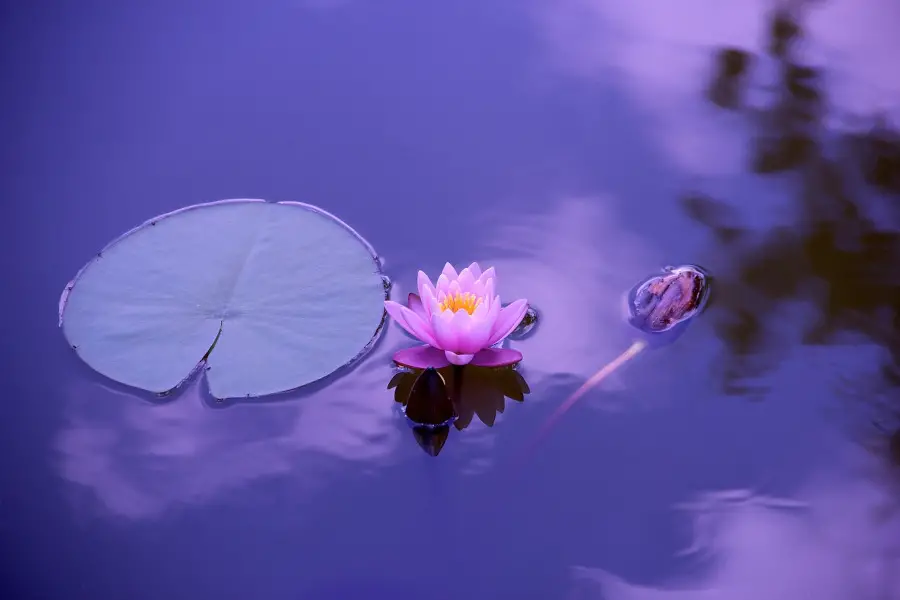
In Chinese culture and Feng Shui practices, the lotus flower (荷花 – héhuā) emerges as a timeless symbol of beauty, purity, and spiritual enlightenment. Revered for centuries, the lotus holds a profound significance in the hearts and minds of the Chinese people, weaving its way through art, literature, religion, and daily life.
From the murky depths of muddy waters, the lotus rises unblemished and pristine, symbolizing the triumph of purity over adversity. Its exquisite petals unfurl gracefully, evoking a sense of serenity and tranquility amidst the chaos of the world.
In Chinese culture, the lotus is more than just a flower; it is a cherished emblem of cultural identity and spiritual aspiration. Its symbolism permeates every aspect of Chinese society, from ancient mythology to modern-day celebrations, enriching the lives of countless individuals with its timeless beauty and profound wisdom.
In this article, we will explore the significance and symbolism of the lotus flower in Chinese culture and Feng Shui. From its ancient origins to its role in Chinese mythology, art, literature, religion, medicine, cuisine, and Feng Shui practices, we will delve into the many ways that the lotus flower has been embraced and celebrated in Chinese culture.
Whether you are a student of Chinese culture, a Feng Shui practitioner, or simply someone who appreciates the beauty and symbolism of the lotus flower, this article will provide a comprehensive overview of the lotus’s significance and symbolism in Chinese culture and Feng Shui.
The Symbolism of Lotus in Chinese Culture
The lotus flower’s symbolic journey in China stretches back centuries, its presence woven into the fabric of the nation’s artistic and literary heritage.
A study from 2023 examined historical records of lotus consumption in China from 9000 to 1100 years before present (BP). It found that Neolithic rice farmers in the Yangtze and Yellow River regions used lotus roots and seeds as a supplementary food source. Additionally, it suggests that the use of lotus for medicinal and cultural purposes evolved during the rise of China’s urban aristocracy from the mid-Warring States to the Late Tang Dynasty. This research establishes the groundwork for understanding the long-term relationship between the Chinese people and the sacred lotus plant. (1)
References to the lotus appear in ancient poems and texts, praising its beauty and resilience. Exquisite lotus motifs adorn pottery, bronzeware, and jade carvings, showcasing its early significance in Chinese art.
The lotus’s ability to rise pristine from murky waters resonated deeply with the Chinese. It became a symbol of purity, untainted by its surroundings. Countless poems celebrate the lotus’s immaculate beauty, comparing its unblemished petals to a virtuous person’s character.
Proverbs like “出淤泥而不染 (chū wū ní ér bù rǎn)”, which translates to “emerging from the mud without being stained,” exemplify how the lotus became a metaphor for moral integrity.
Furthermore, the sound likeness between “lotus” (荷 hé) and “harmony” (和 hé) suggests peace and harmony, adding to its meaning of sanctity and purity.
Varieties of Lotus Found in China and East Asia
| Lotus Variety | Color | Characteristics/Symbolism |
|---|---|---|
| Nelumbo nucifera | White | Symbolizes purity and enlightenment. Commonly associated with spiritual growth and enlightenment. |
| Nelumbo lutea | Yellow | Represents prosperity and wealth. Often used in Feng Shui practices to attract abundance and success. |
| Nelumbo nucifera ‘Rosea’ | Pink | Signifies love, compassion, and emotional healing. Used in ceremonies and rituals to promote harmony in relationships. |
| Nelumbo rubra | Red | Symbolizes passion, vitality, and transformation. Associated with vitality and dynamic energy. |
| Nelumbo caerulea | Blue | Represents wisdom, serenity, and inner peace. Used in meditation practices to promote clarity of thought and spiritual insight. |
Related reading: Plum Blossom in Chinese Culture and Feng Shui (history, legends, how to use it)– Opens in new tab
The Lotus in Chinese Mythology
Within the rich landscape of Chinese mythology and folklore, the lotus occupies a prominent role, weaving its delicate petals into tales of creation, divinity, and transformation. Legends abound with references to the lotus, casting it as a symbol of divine grace and celestial beauty.
Many folktales depict the lotus as a source of life and rebirth. The myth of Nüwa (女媧), the goddess who patched the broken sky, tells of her creating humanity from lotus seeds. Other legends associate the lotus with deities and immortals, who are often depicted sitting or standing on lotus pedestals.
In the genesis stories of Chinese mythology, the lotus emerges as a potent symbol of creation and cosmic order. According to ancient beliefs, the universe was born from a primordial chaos, with the lotus blossoming forth from the murky waters, heralding the dawn of creation.
In Chinese creation myths, the lotus serves as a bridge between the earthly realm and the heavens, symbolizing the harmonious interplay of yin and yang forces. Its ethereal beauty and immaculate form embody the cosmic balance upon which all existence depends, inspiring awe and reverence in those who contemplate its mysteries.
As we delve deeper into the mythological landscape of ancient China, we discover the profound significance of the lotus as a symbol of divine grace and cosmic harmony, reminding us of the interconnectedness of all things in the vast panorama of existence.
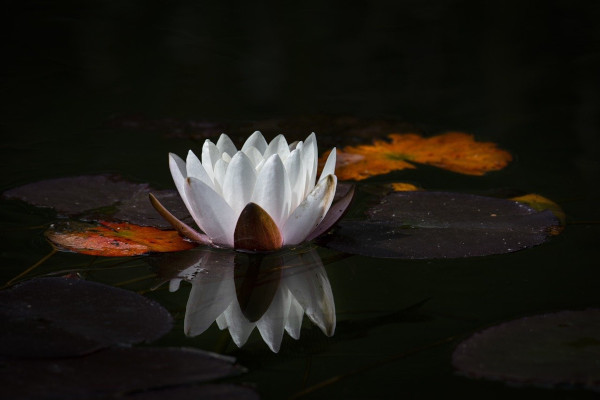
The Lotus in Chinese Art and Literature
The lotus has blossomed not only in myths and legends but also in the vibrant worlds of Chinese art and literature. Its elegant form and symbolic richness have inspired countless artists, poets, and calligraphers for centuries.
From delicate brushstrokes in ink paintings to intricate silk embroidery, the lotus graces a vast array of Chinese art forms. Paintings often capture the lotus in its natural habitat, surrounded by dragonflies and koi fish, symbolizing harmony with nature. Sculptors carve the lotus from jade and other precious materials, highlighting its purity and elegance. The lotus’s graceful form transcends artistic styles, with each era adding its own unique interpretation.
In Chinese poetry, the lotus is often used as a metaphor for beauty, purity, and spiritual growth. For example, the Tang Dynasty poet Wang Changling wrote “The Song of Picking Lotus,” which describes the beauty and elegance of the lotus flower. Another Tang Dynasty poet, Wang Bo, wrote “Pairing the Lotus,” which explores the symbolism of the lotus as a representation of beauty, purity, and spiritual growth. (2)
The lotus is also a popular subject in Chinese calligraphy, where it is often used as a decorative element or as a symbol of beauty and elegance. The lotus is often depicted in a stylized form, with its leaves and petals arranged in a symmetrical pattern. This stylized representation of the lotus is often used to convey a sense of harmony and balance, which is an important concept in Chinese culture.
In Chinese literature, the lotus is often used as a metaphor for love and romance. For example, in the Han Dynasty folk song “Jiangnan,” the lotus is used to describe the beauty and allure of the southern region of China, where the lotus is commonly found. The song describes the lotus as a symbol of beauty, purity, and love, and it is often used as a metaphor for romantic love.
The famous Tang Dynasty poet, Li Bai, uses the lotus metaphor in his verse, “I lie down and watch the clouds drifting north, / While a blue lotus blooms by my side.” This exemplifies the lotus’s association with peace and tranquility.
The Lotus in Chinese Religion
The lotus flower transcends cultural spheres, holding deep significance in the major religions practiced in China: Buddhism, Daoism, and Confucianism. In each tradition, the lotus embodies the path towards spiritual growth and enlightenment.
The Significance of the Lotus in Chinese Religions
- Buddhism: In Buddhism, the lotus is revered as a symbol of purity and liberation from earthly desires. The Buddha is often depicted seated on a lotus throne, representing his state of enlightenment. The lotus’s ability to rise above muddy waters reflects the Buddhist concept of achieving spiritual awakening despite the challenges of life.
- Daoism: Daoism sees the lotus as an embodiment of natural perfection and effortless growth. The lotus’s ability to thrive in both water and mud resonates with the Daoist philosophy of living in harmony with nature. It also symbolizes the concept of wu wei (effortless action), signifying the natural unfolding of spiritual development.
- Confucianism: Confucianism emphasizes moral character and living a virtuous life. The lotus’s unblemished beauty exemplifies the Confucian ideal of remaining upright and ethical amidst any circumstance. It serves as a reminder to cultivate inner purity and integrity.
The Lotus as a Symbol of Spiritual Growth and Enlightenment
Across Chinese religious traditions, the lotus serves as a powerful symbol of spiritual growth and enlightenment. Its roots firmly anchored in the mud, yet its petals reaching towards the heavens, the lotus embodies the transformative journey from darkness to light, from ignorance to wisdom.
As practitioners strive for spiritual perfection, the lotus serves as a guiding beacon, inspiring them to transcend worldly attachments and attain inner peace.
“In Buddhism, the lotus is revered as a sacred flower that symbolizes the journey of enlightenment, with its roots in the mud representing the struggles of life and its blossoms reaching towards the heavens symbolizing spiritual awakening.” – Venerable Master Wu Cheng, Buddhist Monk.
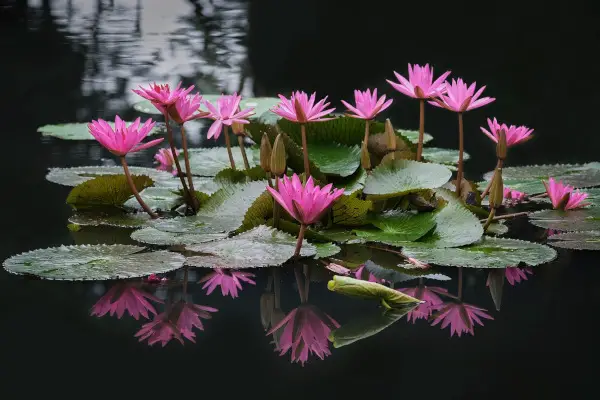
The Lotus in Chinese Medicine
The lotus flower (荷花 – héhuā) isn’t just a symbol of beauty and enlightenment; it’s also a valued medicinal herb in Traditional Chinese Medicine (TCM). For centuries, various parts of the lotus plant have been used to treat a wide range of ailments, showcasing its holistic healing properties.
The lotus seed, also known as Lian Zi ( 莲子), is widely used in TCM to tonify the middle, nourish the spirit, and augment the power of qi. It is also used in formulas like Zhong Zi Wan to aid fertility in women by warming the uterus and strengthening kidney yang.
Lian Fang (莲房), the lotus root receptacles, is used in TCM to tonify and bind the spleen. It is also believed to improve blood circulation and increase organ oxygenation, resulting in increased energy levels. The high potassium content of lotus root helps relax the blood vessels, reducing their constriction and increasing blood flow and blood transport to the brain, reducing stress on the cardiovascular system.
Lian Ye (荷葉), the lotus leaf, is used in TCM to clear heat and stop bleeding. It is also believed to have anti-inflammatory properties, which can fight macrophages and prevent or mitigate inflammatory pathways. The lotus leaf extract contains vitamin C, which enhances immune function and destroys free radicals that often provoke cancer and heart disease. (3)
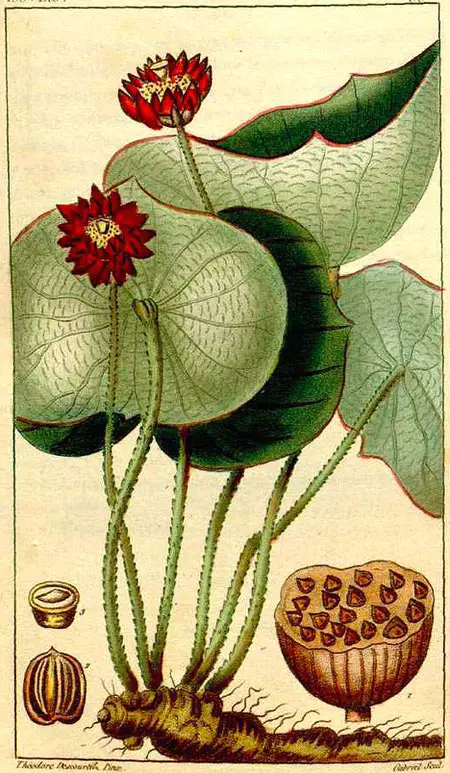
In addition to its medicinal properties, the lotus is also used in skincare due to its sebum-protecting and anti-aging properties. Applying lotus flower extract to the face significantly reduces sebum production, improving the appearance of the skin, especially in patients with oily or combination skin types.
The lotus flower is also high in flavonoids, which reduce the permeability and increase the resistance of blood capillaries, improving skin elasticity, eliminating fine lines and wrinkles, and moisturizing the skin.
Overall, the lotus is a versatile plant with various medicinal properties and uses in TCM and skincare. Its anti-inflammatory, antioxidant, and sebum-protecting properties make it a valuable ingredient in various skincare products, while its ability to tonify and bind the spleen, improve blood circulation, and stop bleeding makes it a popular choice in TCM
“Lotus root has been used for centuries in traditional Chinese medicine for its therapeutic properties, including its ability to strengthen the digestive system and promote overall health.” – Dr. Li Jing, Traditional Chinese Medicine Practitioner.
The Lotus in Chinese Cuisine
The lotus isn’t just a symbol of purity and a source of medicine; it’s also a delightful ingredient in Chinese cuisine! For centuries, chefs have harnessed the lotus’s versatility and subtle flavor to create an array of delicious dishes.
The entire lotus plant finds its way onto the Chinese dinner table. Lotus root, with its crunchy texture and mild sweetness, is a popular choice. It can be stir-fried, sliced and added to soups, or even ground into flour for dumplings. Lotus seeds, known for their nutty flavor, are often used in sweet dishes like soups, puddings, and mooncakes. Fresh lotus flowers add a touch of elegance to salads and can even be stuffed with savory fillings.

Various Ways Lotus is Prepared and Served in Chinese Dishes
The preparation methods for lotus dishes vary greatly depending on the region and specific dish. Here are a few examples:
- Stir-fried Lotus Root: Thinly sliced lotus root is stir-fried with chili peppers, garlic, and other vegetables for a quick and flavorful side dish.
- Lotus Root Soup: Lotus root chunks simmered in a flavorful broth with pork or chicken create a comforting and nutritious soup.
- Stuffed Lotus Flowers: The delicate lotus flower petals are filled with a savory mixture of glutinous rice, minced meat, and vegetables, then steamed to create a visually stunning and delicious dish.
- Lotus Seed Paste: Lotus seeds are boiled, mashed, and sweetened to create a smooth paste that’s used as a filling for pastries or enjoyed on its own as a dessert.
The lotus flower’s presence in Chinese cuisine extends beyond its taste. Its beautiful blooms are often used as garnishes, adding a touch of nature’s artistry to the presentation. Whether enjoyed for its flavor, symbolism, or visual appeal, the lotus remains a treasured ingredient in Chinese culinary traditions.
Check out delicious lotus recipes at chinasichuanfood.com. You will love it!
The Lotus in Chinese Festivals and Celebrations
The lotus flower isn’t just a beautiful symbol or a medicinal herb; it’s also intricately woven into the fabric of Chinese festivals and celebrations. Its presence signifies renewal, harmony, and auspicious beginnings, making it a beloved motif throughout the year.
The Role of the Lotus in Chinese Festivals and Celebrations
From grand national holidays to intimate family gatherings, the lotus flower adds a touch of symbolism and beauty to various celebrations.
- Chinese New Year: During this joyous festival that marks the beginning of the lunar year, homes are often adorned with papercuts or paintings featuring lotus flowers. These symbolize a fresh start, purity, and the hope for a prosperous year ahead. Lotus seed snacks are also popular treats, representing rebirth and new beginnings.
- Dragon Boat Festival: This festival, held on the fifth day of the fifth lunar month, commemorates the poet Qu Yuan. Legend has it that people threw glutinous rice dumplings wrapped in lotus leaves into the river to prevent fish from eating his body. Today, lotus leaf-wrapped rice dumplings remain a traditional food item enjoyed during this festival.
- Mid-Autumn Festival: Also known as the Moon Festival, this celebration centers around reunion and family. Mooncakes, a traditional pastry with various fillings, are often shaped like lotus flowers, symbolizing harmony and completeness within the family circle.
- Lantern Festival: Held on the fifteenth day of the first lunar month, this festival marks the end of the Chinese New Year celebrations. Lanterns in the shape of lotus flowers illuminate the night sky, signifying the dispelling of darkness and the dawning of a bright future.
The lotus flower’s journey through Chinese culture is a testament to its enduring significance. From its symbolic presence in art and literature to its practical applications in medicine and cuisine, the lotus flower continues to capture hearts and minds. Its presence in festivals and celebrations further solidifies its role as a cherished symbol of Chinese culture and tradition.
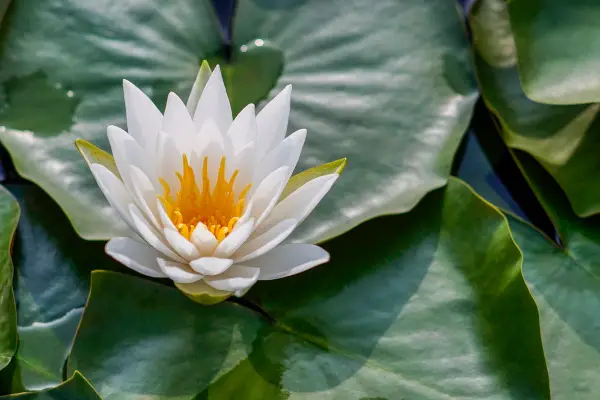
The Role of Lotus in Feng Shui Practices
The lotus flower’s journey in Chinese culture culminates in its powerful role within the practice of Feng Shui. Here, the lotus symbolizes purity, resilience, and spiritual enlightenment. Its ability to rise unblemished from muddy waters represents the journey of overcoming obstacles and achieving personal growth. By incorporating lotus imagery into the home or workplace, practitioners seek to imbue their spaces with the qualities of grace, beauty, and inner peace.
The presence of lotus imagery in Feng Shui practices is believed to harmonize energies and enhance the flow of chi, or life force energy, throughout the space. Just as the lotus thrives in tranquil waters, so too does it promote a sense of calm and serenity in the environment. By fostering a harmonious balance of yin and yang energies, lotus imagery encourages positivity, creativity, and abundance to flourish.
The lotus is also believed to enhance the flow of chi, the invisible life force that nourishes all living things. By strategically placing lotus symbols or artwork, you can encourage the flow of positive chi throughout your space.
Related reading: The Chrysanthemum in Chinese Culture and as Feng Shui Symbol – Opens in new tab
Placement of Lotus in Feng Shui
Now that we understand the lotus flower’s role in harmonizing energies and enhancing chi flow, let’s explore how to harness its power through strategic placement in your home or office.
Optimal Locations for Lotus Decor and Artwork
The lotus’s symbolism and energy vary depending on its placement within a specific zone of the Bagua map, a tool used in Feng Shui to map energy areas. Here are some key areas to consider:
- East Zone (Family & Health): A vibrant lotus painting in the east sector can promote a sense of well-being and nurture strong family bonds.
- Southeast Zone (Wealth & Prosperity): Pink lotus sculptures placed strategically in the southeast zone are believed to attract positive energy and abundance.
- South Zone (Fame & Recognition): A ceramic lotus vase filled with fresh red lotus flowers in the south zone can amplify your reputation and attract recognition.
- North Zone (Career & Life Path): A white lotus statue placed on your work desk in the north zone is said to enhance clarity, focus, and career growth.
- Center Zone (Balance & Harmony): A crystal lotus mobile hanging in the center of your living space can promote overall balance and a sense of peace within your home.
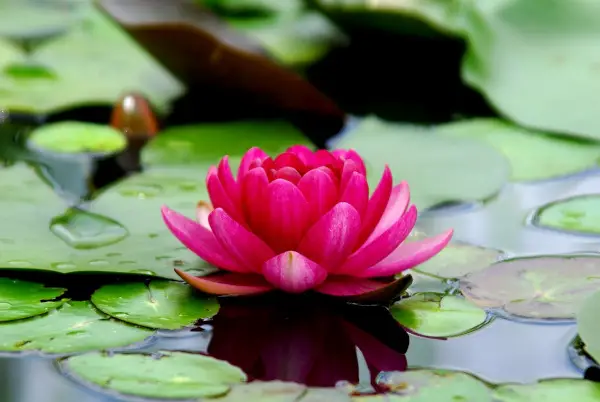
Beyond the Bagua Map
While the Bagua map offers valuable insights, remember that Feng Shui is also about personal intuition. If you feel drawn to placing a lotus image in a specific area, trust your instincts! Here are some additional tips:
- Living areas: A lotus painting above your sofa can create a welcoming and harmonious atmosphere.
- Entryway: A lotus doormat or a lotus-shaped bowl filled with potpourri near the entrance can usher in positive energy.
- Bedroom: A serene lotus print on your bedroom wall can promote restful sleep and tranquility.
- Office or Workspace: Displaying a lotus sculpture or painting near the desk inspires creativity and productivity, while promoting a harmonious flow of energy throughout the workspace.
- Meditation Area: Placing a lotus tapestry or statue in the meditation space encourages deep introspection and connection with the divine, facilitating a sense of inner peace and harmony.
Remember
- The material of the lotus decor also plays a role. Crystal lotuses can enhance clarity, while ceramic lotuses promote stability.
- Ensure the lotus artwork or object is in good condition. Wilted or broken lotus symbols can have the opposite effect, hindering the flow of positive chi.
Want to learn more about Feng Shui? Check out our suggestions: Feng Shui Bookshelf – Opens in new tab
Lotus as a Feng Shui Cure
We’ve explored the lotus flower’s ability to harmonize energies and enhance chi flow. But what if your space suffers from existing imbalances or disharmony? The lotus, in its enduring resilience, can also act as a powerful Feng Shui cure, helping to restore balance and promote positive change.
Remedies for Imbalance and Disharmony
Here’s how the lotus flower can be used as a Feng Shui cure to address specific challenges:
- Stagnant Energy: If your space feels heavy or lacks vitality, a vibrant red or orange lotus flower painting can activate stagnant energy and stimulate positive chi flow.
- Arguments and Conflict: The calming energy of a white or blue lotus sculpture placed in a common area can help ease tension and promote a more peaceful atmosphere.
- Lack of Focus or Creativity: A metal lotus wind chime hanging near your workspace can enhance mental clarity and encourage creative inspiration.
- Countering Harsh Energy: Does a space feel overly harsh or dominated by sharp angles? A white or blue lotus sculpture can introduce a sense of calmness and tranquility.
- Overcoming Gossip and Rumors: If your home or office suffers from excessive gossip or negativity, a crystal lotus placed strategically can deflect negativity and promote open communication.
- Financial Difficulties: A healthy, potted lotus plant placed in the southeast wealth zone (identified using the Bagua map) is believed to attract prosperity and financial abundance.
Remember: A Feng Shui cure is most effective when combined with other strategies. For instance, decluttering a space can further enhance the positive effects of a lotus cure.
The Power of Intention
The lotus flower, with its symbolic connection to overcoming challenges, serves as a constant reminder of the power of intention. By strategically placing lotus decor and setting clear intentions, you can harness the lotus’s energy to transform your space and cultivate a more harmonious and supportive environment.
Feng Shui consultant Laura Cerrano suggests, “A crystal lotus placed strategically can deflect negativity and promote open communication, especially if your home or office suffers from excessive gossip or rumors.”

Symbolism of Lotus Colors
In Chinese culture and Feng Shui, the colors of lotus flowers hold specific symbolic meanings, each representing different aspects of life, spirituality, and emotion.
Here’s a breakdown of some popular lotus colors and their associated symbolism:
White Lotus: Often referred to as the “sacred lotus,” the white lotus symbolize purity, innocence, and spiritual enlightenment. Associated with the highest levels of consciousness, the white lotus represents transcendence and the attainment of inner peace. In Feng Shui, it’s ideal for the Center Zone or the North Zone, promoting clarity of mind, purity of intention, and the cultivation of spiritual wisdom.
Pink Lotus: Pink lotus flowers are often associated with love, compassion, and emotional healing. Their delicate hue evokes feelings of tenderness and affection, making them a popular choice for romantic gestures and heartfelt expressions. In Feng Shui, a pink lotus placed in the East Zone (Family & Health) can nurture strong family bonds and cultivate loving relationships.
Red Lotus: Red lotus flowers symbolize passion, vitality, good fortune, abundance and transformation. The vibrant color of red lotus petals signifies the fiery energy of life force and the power of spiritual awakening. Red lotus is a powerful symbol of prosperity. Strategically placing a red lotus image or sculpture in the Southeast Zone (Wealth & Prosperity) is believed to attract positive energy and financial success. Additionaly, red lotus decor stimulates energy flow and vitality, promoting courage, confidence, and dynamic action.
Blue Lotus: The rarest of the lotus colors, blue lotus represent wisdom, serenity, and inner peace. Their calming hue soothes the mind and uplifts the spirit, making them a symbol of tranquility and spiritual insight. In Feng Shui, a blue lotus placed in your workspace (North Zone – Career & Life Path) can enhance your problem-solving skills, clarity of thought, and attract opportunities for advancement.
Using Color Combinations
In some cases, you might encounter lotus artwork or decor featuring multiple colors. Here’s how to interpret these combinations:
- Pink and White Lotus: This pairing signifies a harmonious balance between love (pink) and spiritual growth (white). Ideal for the Relationship Zone (Southwest).
- Red and White Lotus: This combination represents a balance between passion (red) and purity (white). Well-suited for the South Zone to attract success while maintaining integrity.
Related reading: Peonies in Chinese Culture and Feng Shui (History, Meaning, How to use it) – Opens in new tab
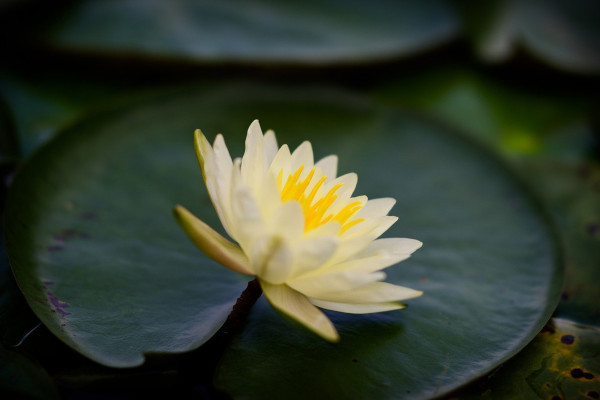
The Meaning of Dreaming of Lotus Flower in Chinese Culture
In Chinese culture, dreaming of a lotus flower is considered auspicious and carries deep symbolic significance. Such dreams are believed to convey messages from the subconscious and are often interpreted as positive omens or indicators of spiritual growth.
Symbolism of Lotus Flower in Dreams
Dreaming of a lotus flower is often interpreted as a sign of purity, enlightenment, and spiritual awakening. The lotus, with its ability to emerge unblemished from muddy waters, symbolizes the journey of overcoming obstacles and achieving higher levels of consciousness. Thus, dreaming of a lotus may suggest that the dreamer is on a path of personal growth and transformation.
Interpretations of Different Dream Scenarios
- Blooming Lotus: Dreaming of a lotus in full bloom is considered especially auspicious, symbolizing the fulfillment of one’s potential and the realization of dreams and aspirations.
- Closed Lotus Bud: A closed lotus bud in a dream may suggest that the dreamer is at the beginning stages of their spiritual journey, with potential for growth and development yet to be fully realized.
- Multiple Lotus Flowers: Dreaming of multiple lotus flowers may indicate abundance, prosperity, and harmony in various aspects of life, including relationships, career, and health.
- Offering Lotus Flowers: If the dreamer is offering lotus flowers to others or receiving them as gifts, it may signify acts of kindness, compassion, and spiritual generosity.
Guidance for Dream Interpretation
While dreaming of a lotus flower is generally regarded as positive, the specific interpretation may vary depending on the dreamer’s personal experiences, emotions, and cultural background. Consider your current life situation and how the dream’s imagery resonates with you to gain the most meaningful insights from your lotus flower dream.
End Words
China’s fascination with the lotus flower transcends time. From a symbol of purity in art and literature to a source of medicine and culinary inspiration, the lotus permeates every facet of Chinese culture.
Feng Shui embraces the lotus’s energy, using its placement to cultivate harmony and auspicious beginnings. The lotus flower’s enduring allure serves as a reminder of hope, resilience, and the potential for beauty to bloom even in life’s murkiest depths.
Want to learn more about Feng Shui? Check out our suggestions: Feng Shui Bookshelf – Opens in new tab
Sources
1. Ma, Tian & Zhou, Yijing & Pengfei, Sheng & Jiang, Hongen. (2023). Archaeobotanical evidence reveals the early history of sacred lotus (Nelumbo nucifera Gaertn.) use in China. Genetic Resources and Crop Evolution. 70. 1-8. 10.1007/s10722-023-01558-z.
2. Huang, H. Y. (2020). Study on the Oil Painting Language Study of the Image of Lotus in Ancient Poems. Open Journal of Social Sciences, 8, 111-119. https://doi.org/10.4236/jss.2020.811011
3. Zheng H, Han L, Shi W, Fang X, Hong Y, Cao Y. Research Advances in Lotus Leaf as Chinese Dietary Herbal Medicine. Am J Chin Med. 2022;50(6):1423-1445. doi: 10.1142/S0192415X22500616. Epub 2022 Jun 30. PMID: 35770727.
Stay in Touch
 Join our newsletter by using the forms on this website or click here!
Join our newsletter by using the forms on this website or click here! Follow us on Google News
Follow us on Google News Follow us on Facebook
Follow us on Facebook




